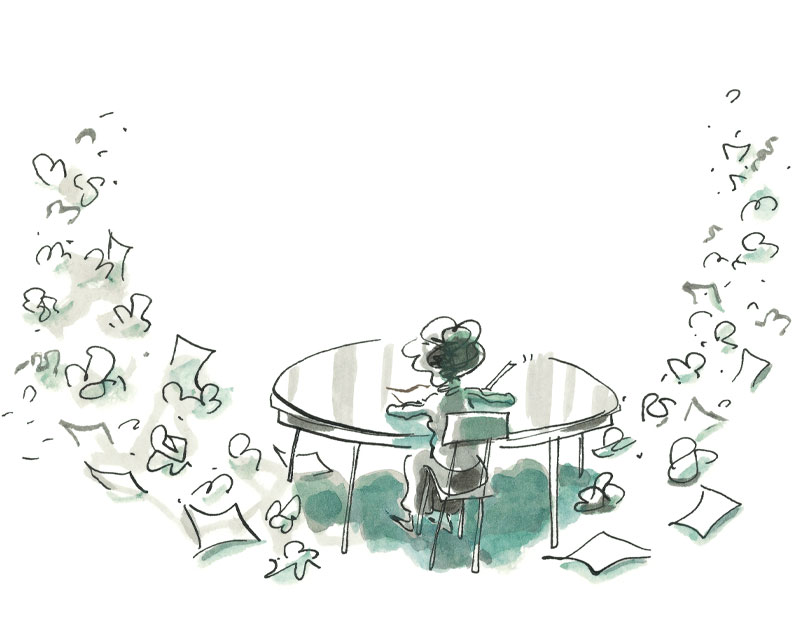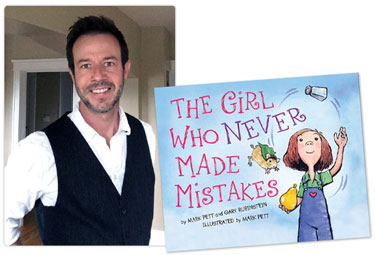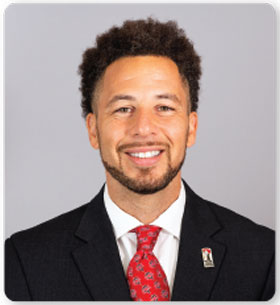When “Perfect” Is a Pitfall: Recognizing perfectionism in students, and books to help
Educators may naturally seek to help those who are struggling at school, but some high performers can need a different kind of support—to know that imperfect is OK.
 |
Art from ISH. Text and illustrations copyright © 2004 by Peter H. Reynolds.
|
 |
Mark Pett |
When children’s book author Mark Pett was a kid, he got a 99 on a math test and excitedly told his mom. She responded, “What did you miss?”
“I just remember that sense of deflation,” recalls Pett, a creator of books including The Girl Who Never Made Mistakes, coauthored with Gary Rubinstein (Sourcebooks Jabberwocky, 2011). He also thought, “If I could just be perfect, how wonderful life would be.”
In high school, Pett won a math contest with a perfect score, but his joy quickly ceded to fear. “You know you can’t maintain it,” he says.
The scientific explanation for “self-oriented perfectionism” boils down to feeling that you won’t be OK unless you’re flawless. That’s the case with Beatrice, of The Girl Who Never Made Mistakes. The bar is set unreachable at the get-go or starts off just ambitious and inches higher. When these perfectionists fall short, self-recrimination follows. When they succeed, there’s pressure to stay flawless. They also tend to have all-or-nothing thinking, catastrophize, and focus on what’s going wrong rather than right. Many set up rigid rules.
Kids display perfectionist tendencies for different reasons, and while educators may naturally seek to help those who are struggling at school, some high performers may need a different kind of help—to know that imperfect is OK.
[READ: Celebrate Imperfection with These 27 Titles for Young Children]
Like Beatrice, who won’t ice skate with her friends because she’s worried about making a mistake, perfectionist children often shy away from new experiences, embrace a fixed mind-set, and can even equate having to work hard with being a failure.
This isn’t the same as striving for excellence; rather, it involves a contingent sense of self-worth and concern about not being good enough that can be tied to anxiety, overthinking, low self-esteem, and eating disorders, as Gordon L. Flett and Paul L. Hewitt write in Perfectionism in Childhood and Adolescence (American Psychological Association, 2022).
Rates of “socially prescribed” perfectionism in childhood and adolescence have risen over the last two decades—alongside social media, Flett says. These kids may think that others expect them to appear perfect. Here, the concern is less with being perfect and more with seeming perfect. There’s worry about being accepted and reliance on external validation. Between 25 percent and 32 percent of adolescents experience some form of maladaptive perfectionism, Flett and Hewitt estimate.
 |
|
Author/illustrator Peter H. Reynolds |
Author-illustrator Peter H. Reynolds got the idea for his book Ish (Candlewick, 2004) while encouraging kids to draw animals in a classroom in Maine. “I noticed a boy erasing his drawing which, just a few minutes earlier, I had noticed was bold and dynamic,” Reynolds says. The boy told him it was supposed to be a tiger but didn’t look like one. “Well, it looks tiger-ish!” Reynolds replied.
Those words eased stress and bred confidence in the child. “Thinking ish-ly allowed his ideas to flow freely,” Reynolds writes in Ish, and “felt wonderful.”
Reynolds has had “bouts” of perfectionism himself but has realized that speed allows him “to be less obsessive about a drawing and just move on.” When he fell asleep with his pen one day, ink seeped into paper for an hour, leaving a big dot. That inspired The Dot (Candlewick, 2003), about encouraging kids to start. The Dot pairs well with Ish, which prompts them to keep going, Reynolds says.
Terry Shay, a K–12 vocal music teacher at North Tama School in Traer, IA, took The Dot’s message so much to heart that in 2009, he launched International Dot Day. It’s a “global celebration of creativity, courage, and collaboration,” now celebrated by millions of people annually on “September 15-ish,” according to the International Dot Day site. Reynolds’s nonprofit, the Reynolds Center for Teaching, Learning, and Creativity, also supports creativity in education.
Kids need the courage to be imperfect. Flett says teachers tell him all the time about students who, “If something is not working out right away, they’ll rip it up.” Others rewrite and recheck excessively when journaling or doing math. Some are stuck in indecision and don’t start projects until it’s too late. Others stop at the first hurdle.
Educators could hand those students The Book of Mistakes by Corinna Luyken (Dial, 2017), focusing on “marvelous mistakes” and how to respond when things aren’t perfect. The bestselling Rosie Revere, Engineer by Andrea Beaty, illustrated by David Roberts (Abrams, 2013), also reframes what it looks like to learn: “Your brilliant first flop was a raging success.” Mistakes aren’t a problem, these books communicate; they’re an essential part of growing and living.
 |
J. Luke Wood |
Flawless or bust
What makes a perfectionist? Depending on the kid, Flett says, “how they got there and why they are perfectionistic can be very, very different.” He and Hewitt point to everything from inherited traits and temperament to interactions early in life.
For a child with a self-oriented perfectionist for a caregiver or educator, it can feel like anything less than flawlessness chips away at how much they’re loved.
Other children who have perceived caregivers as indifferent, unavailable, incapable, or unreliable can wind up seeing themselves as inherently flawed or lacking intrinsic value. A constant struggle to prove their worth often results.
Positive attention can breed perfectionism, too: Kids who get a lot of the wrong kind of praise can feel like their value depends on being eternally awesome. Caregivers who overprotect and micromanage may send the message that mistakes are the end of the world. So too do perfectionist parents, siblings, and others who children look up to.
Perfectionistic tendencies can also develop in response to grief or trauma; it’s a way to exert control in a world that’s out of control. Reports on the pandemic’s effect are mixed: In some cases, distance learning relieved pressure on students, while other reports indicate a heightened need to be perfect or no change in their parents’ or schools’ expectations despite the upheaval.
And school climates can have an impact. Research on high-achieving schools shows higher rates of anxiety and depression, thanks to some combination of perfectionistic climate and social comparison.
J. Luke Wood, a professor of education at San Diego State University, explains that “stereotype threat” can also engender perfectionism. “You have students who are concerned with reinforcing stereotypes in their environment,” he explains.
“Perfectionism is perceived to be a white thing, just like intelligence is perceived to be a white thing,” says Wood. Flett says that studies on African American children and perfectionism show otherwise.
In the Black community, children are often told “you have to work twice as hard,” Wood says. His research in schools shows evidence of Black students having their displays of intelligence ignored or met with incredulity. Perfectionism can be seen as a rational response to the way Black, Indigenous, and Latinx children are often overlooked when it comes to both academic needs and successes, he adds. “If you aren’t perfect, you won’t be given that time or attention.”
Research published in 2011 looked at 661 early adolescents from mostly Black, low-income families and found that 41 percent of them fell into the “high-perfectionism group,” a statistic Wood calls “astronomical.” A 2014 paper looked at experiences of racism, perfectionism, and depression among students, finding that “[R]acial discrimination in Grade 7 predicted Grade 8 levels of socially prescribed perfectionism, which in turn predicted depression in Grade 9.”
Wood points to racial disparities in school-based discipline as well. Black children’s mistakes aren’t treated as marvelous.
“If you make mistakes, you are only fitting into that stereotype,” he says. With these high and inequitable stakes, some children who excel have “prove-them-wrong syndrome,” Wood adds. “They are also broken.”
A 2021 paper in American Psychologist suggests a related pattern of depression and isolation in Asian American students who experience discrimination in high-achieving schools. These students may also be contending with the “model minority myth,” a well-documented phenomenon whereby children of Asian descent are expected to be intelligent and diligent.
 |
Kristine Enderle, editorial director at Magination Press |
Crafting the message
San Francisco Unified School District recently attempted to ease the pressure on kids by distributing How To Take the ACHE Out of Mistakes by Kimberly Feltes Taylor and Eric Braun (Free Spirit, 2019) to 4,000 students entering fifth grade. But how much help can books like these provide? Flett says that for some, the characters’ narratives can lend perspective and self-awareness, but others still need therapeutic treatment. Adults, however, can help by modeling books’ positive messages, intentionally making mistakes as they read aloud and then laughing them off, Flett adds.
Author and clinical psychologist Lynn Jenkins also wanted to offer caregivers a way to “intervene in that little budding [perfectionist] belief system as early as we can.” That’s what she set out to do in Perfect Petunias (Exisle, 2018), from a series that uses one character to personify kids’ problems and another their coping techniques. Jenkins says this strategy helps tots recognize harmful and helpful patterns. She describes watching her son learning to write the letter “a.” His penmanship was fine, but “through his eyes, it wasn’t fine,” she says. Watching her “little clients” grapple with similar self-recrimination by, for instance, looking at another child’s work and saying, “I’m not as good a drawer as her,” also motivated Jenkins.
Books like these have gained popularity with increasing awareness and destigmatization of mental health issues, says Kristine Enderle, editorial director at Magination Press, a children’s book imprint of the American Psychological Association. Magination originally published books mainly as tools for psychologists, but over time started releasing titles including picture books and workbooks that libraries, schools, and families buy directly. “Not everyone can get to therapy,” Enderle says, but they can pick up a book. These titles written by mental health professionals can “kind of bridge the gap and provide them with the tools they need to help themselves.”
Of Beatrice, Pett says, “She’s a much more likable character at the end than she is at the beginning.” With that transformation he wanted to communicate to readers: “That you are OK inherently and intrinsically, that you are not the sum total of your achievements.”
In back-to-school season, it’s a message that educators can convey to students of all ages: Perfection isn’t required, good enough is good enough, and every child—and every child’s creation—has inherent value.
Gail Cornwall is a former teacher and recovering lawyer who now works as a mother and freelance writer in San Francisco.
RELATED
The job outlook in 2030: Librarians will be in demand
The job outlook in 2030: Librarians will be in demand
ALREADY A SUBSCRIBER? LOG IN
We are currently offering this content for free. Sign up now to activate your personal profile, where you can save articles for future viewing





Add Comment :-
Be the first reader to comment.
Comment Policy:
Comment should not be empty !!!